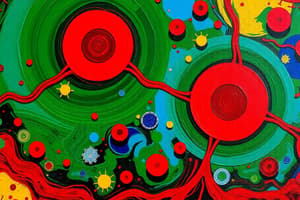Podcast
Questions and Answers
What is hematology primarily concerned with?
What is hematology primarily concerned with?
- The scientific study of blood structure and function (correct)
- The examination of digestive disorders
- The analysis of lung capacity
- The study of skin diseases
Which of the following is NOT a function of blood?
Which of the following is NOT a function of blood?
- Excitation of muscle contraction (correct)
- Defense against infections
- Regulation of body temperature
- Transport of carbon dioxide
What is the normal pH range of blood?
What is the normal pH range of blood?
- 7.35 - 7.45 (correct)
- 6.95 - 7.05
- 7.45 - 7.55
- 7.25 - 7.35
How much of the body weight does blood approximately account for in a normal adult?
How much of the body weight does blood approximately account for in a normal adult?
Which element is a major component of the liquid phase of blood?
Which element is a major component of the liquid phase of blood?
Flashcards are hidden until you start studying
Study Notes
Hematology
- The study of blood, bone marrow, and the hemostasis system.
- Includes disorders of lymph nodes and related tissues.
- Encompasses a range of diseases including:
- Genetic diseases (e.g., hemoglobinopathies, thalassemias)
- Immune diseases (e.g., immune hemolytic anemia)
- Malignancies (e.g., leukemias, lymphomas).
- Has played a crucial role:
- Studying blood and its disorders
- Understanding gene structure and function
- Recognizing the importance of chromosomal abnormalities in malignancies
- Advancing molecular biology of neoplasia
Blood
- Constitutes 6-8% of body weight in healthy adults.
- Total volume is approximately 5 liters.
- Distribution:
- Systemic veins: 3 liters
- Arterial system: 1 liter
- Lungs: 1 liter
- Specific gravity: 1.050 - 1.060
- Viscosity: 2-5 times that of water
- Salinity: 0.85
Blood Functions
- Respiration:
- Transport of oxygen from lungs to tissues.
- Transport of CO2 from tissues to lungs for excretion.
- Nutrition:
- Transports absorbed food materials from the digestive system to other parts of the body.
- Excretion:
- Transports metabolic wastes to kidneys, lungs, skin, and intestines for removal.
- Acid-Base Balance:
- Maintains normal blood pH (7.35-7.45).
- Water Balance:
- Regulates water exchange between circulating fluid and tissue fluid.
- Temperature Regulation:
- Distributes body heat; blood temperature is 38°C.
- Defense:
- Provides defense against infection through white blood cells (WBCs) and circulating antibodies.
- Hormone Transport:
- Transports hormones for metabolic regulation.
Blood Composition
- Consists of two phases:
- Liquid phase (plasma):
- Water, electrolytes (Na+, Ca++, HCO3-, Cl-), proteins, and other substances like sugar, fat, vitamins, and hormones.
- Solid phase (formed elements):
- Erythrocytes (red blood cells)
- Leukocytes (white blood cells)
- Platelets
- Liquid phase (plasma):
Blood Components
-
Plasma: 55% of blood volume
- Serum: Plasma without fibrinogen, fibrin, Factor II, Factor V, Factor VIII. Rich in serotonin.
- Fibrinogen: Key component of blood clotting.
-
Solid Phase: 45% of blood volume
- Red blood cells, white blood cells, and platelets.
Plasma
- Normal volume: 25-45 ml/kg of body weight.
- Specific gravity: 1.027.
- Components:
- Approximately 92% water
- 8% substances including proteins, ions, nutrients, gases, and waste products.
- Plasma proteins:
- Albumin: 60% of plasma proteins; important for osmotic pressure of blood and water movement.
- Globulin: 36% of plasma proteins; includes antibodies and complement (important in immune system).
- Fibrinogen: 4% of plasma proteins; crucial for blood clot formation.
Plasma Volume
- Remains relatively constant.
- Water intake: Digestive tract
- Water loss: Kidneys, lungs, digestive tract, skin.
Composition of Plasma
-
Electrolytes: Cations (Na+, K+, Mg++) and anions (Cl-, HCO3-, SO4, PO4).
-
Proteins: Albumin, globulin, fibrinogen, transferrin, haptoglobin, hemopoietin.
-
Other contents: Cholesterol, triglycerides, lipoproteins, glucose, urea, uric acid, iron, coagulation factors.
-
Note: All plasma proteins are produced by the liver except for gamma-globulin, which is produced by plasma cells.
Functions of Plasma Proteins
- Osmotic pressure (oncotic pressure): Maintained at 25 mmHg, primarily by albumin. Hypoalbuminemia can lead to reduced oncotic pressure and edema.
- Transport system: Many substances are transported in the blood by plasma proteins:
- Albumin: Ca+2, bilirubin, sulpha drugs.
- Alpha-globulin: B12, thyroxin (T3), cortisol.
- Beta-globulin: Cholesterol, lipids, insulin, vitamin A, PO4, K+.
Studying That Suits You
Use AI to generate personalized quizzes and flashcards to suit your learning preferences.




